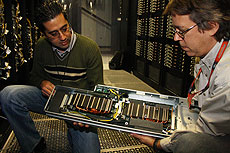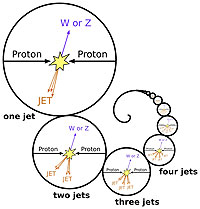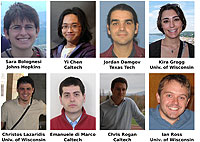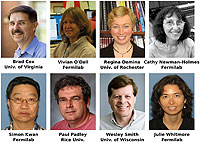|
Have a safe day!
Friday, Jan. 20
3:30 p.m.
DIRECTOR'S COFFEE BREAK - 2nd Flr X-Over
4 p.m.
Joint Experimental-Theoretical Physics Seminar - One West
Speaker: Shalhout Shalhout, University of California, Davis
Title: Search for Dark Matter in Monojet Events at CDF
5:15
After-hour shuttle
With pick-up in front of Wilson Hall, the free shuttle has service to SiDet, CDF, DZero and the User's Center.
8 p.m.
Fermilab Lecture Series - Ramsey Auditorium
Speaker: Dr. Rocky Kolb, University of Chicago
Title: Our Expanding Cosmic Horizons
Monday, Jan. 23
2:30 p.m.
Particle Astrophysics Seminar - One West
Speaker: Alvaro Chavarria, Princeton University
Title: First Evidence of pep Solar Neutrinos by Direct Detection in Borexino 1
3:30 p.m.
DIRECTOR'S COFFEE BREAK - 2nd Flr X-Over
4 p.m.
All Experimenters' Meeting - Curia II
Special Topics: T-958: FP420 (CMS+ATLAS) Fast Timing Group at the FTBF;
T-992: Radiation-Hard Sensors at FTBF for the SLHC
Click here for NALCAL,
a weekly calendar with links to additional information.
Upcoming conferences
|
|
Friday, Jan. 20
- Breakfast: Chorizo burrito
- New England clam chowder
- Carolina burger
- Tuna casserole
- Smart cuisine: Dijon meatballs over noodles
- Bistro chicken & provolone panini
- Assorted sliced pizza
- Carved top of beef*
*carb-restricted alternative
Wilson Hall Cafe Menu
|
|
Friday, Jan. 20
Dinner
Closed
Wednesday, Jan. 25
Lunch
- Crispy chipotle lime tilapia w/ avocado sauce
- Corn & black bean salad
- Cold lime soufflé
Chez Leon Menu
Call x3524 to make your reservation. |
|
New GPUs power through complex QCD calculations
 |
|
Amitoj Singh and Don Holmgren display one of the new GPUs installed to calculate lattice QCD. Credit: Brad Hooker
|
As Fermilab employees bundle up and head out into the cold at the close of each day, the Grid Computing Center stays hot – literally. The center hums with the sound of cooling fans, as thousands of processors drill away at a single problem in a series of enormously complex calculations known as lattice quantum chromodynamics.
QCD, the theory of quarks and gluons, is a way of relating the unusual interactions of these fundamental particles to what can be observed in experiments. The method for determining the properties of particles that contain these quarks and gluons is called lattice QCD. Created in the early 1970s, this intensive calculation system has gained strength in recent years with the advent of high-powered computer processors.
The newest edition to the GCC is a cluster of graphics processing units. These GPUs power through data faster than any nodes in the building, at more than five times the rate of the CPUs of the previous generation.
The cluster is part of a national project called USQCD. This collaboration, incorporating nearly every lattice theorist in the country, develops the computing software and hardware needed to meet the high demands of lattice QCD.
"Lattice calculations are exciting because, as they improve more and more, they give us a cleaner and cleaner search for effects beyond the Standard Model that haven't been discovered yet in the dynamics of the particles containing quarks," said Paul Mackenzie, spokesman for the national collaboration of QCD and a theoretical physicist at Fermilab.
The calculations, requiring tens of thousands of processors, have propelled a constant evolution in processing cores at the laboratory. With the number of transistors in one core doubling approximately every two years, the nodes at Fermilab are superseded by a new generation of processors every two to four years.
Read more
—Brad Hooker
|
Fermilab's Tuition Assistance Program degree recipients
 |
|
These individuals received degrees through Fermilab's Tuition Assistance Program. From left: Martha Garcia, FE, BS in Business Administration; Stephen Cozzens, AD, BS in Business Administration; Linda Bashaw, AD, BS in Information Technology. Not pictured: Herman Cease, PD, PhD in Materials Science and Engineering; Matthew Domeier, AD, AA in Science; Alex Hernandez, BS, BS in Network and Communication Management.
Photo: Cindy Arnold
|
|
Superstuff: When quantum goes big
From New Scientist, Jan. 16, 2012
In the coldest labs in the universe, bucketfuls of liquid flow uphill and solids pass through one another
For centuries, con artists have convinced the masses that it is possible to defy gravity or walk through walls. Victorian audiences gasped at tricks of levitation involving crinolined ladies hovering over tables. Even before then, fraudsters and deluded inventorrs were proudly displaying perpetual-motion machines that could do impossible things, such as make liquids flow uphill without consuming energy. Today, magicians still make solid rings pass through each other and become interlinked - or so it appears. But these are all cheap tricks compared with what the real world has to offer.
Cool a piece of metal or a bucket of helium to near absolute zero and, in the right conditions, you will see the metal levitating above a magnet, liquid helium flowing up the walls of its container or solids passing through each other. "We love to observe these phenomena in the lab," says Ed Hinds of Imperial College, London.
This weirdness is not mere entertainment, though. From these strange phenomena we can tease out all of chemistry and biology, find deliverance from our energy crisis and perhaps even unveil the ultimate nature of the universe. Welcome to the world of superstuff.
Read more
|
Decoding cosmological data could shed light on neutrinos, modified gravity
From PhysOrg.com, Jan. 16, 2012
Today's most powerful telescopes collect huge amounts of data from the most distant locations of the universe – yet much of the information is simply discarded because it involves small length scales that are difficult to model. In an effort to waste less data from cosmological surveys, a team of scientists has developed a new technique that allows researchers to use otherwise unusable data by "clipping" some of the highest density peaks, which present the greatest challenge to models. This data could provide a way to address some unsolved problems in physics, including estimating the neutrino mass and investigating theories of modified gravity.
The scientists, Fergus Simpson, Alan Heavens, and Catherine Heymans from the University of Edinburgh, and J. Berian James from the Dark Cosmology Centre in Copenhagen, Denmark, and the University of California, Berkeley, have published their study in a recent issue of Physical Review Letters.
"The pattern formed by galaxies in our Universe is often referred to as the cosmic web, as it bears some resemblance to the structures seen in an intricate spider web," Simpson told PhysOrg.com.
Read more
|
|
One jet, two jets, three...
 |
| When a proton collision creates a W or Z boson and jets, it is about five times less likely to make two jets than one, and another five times less likely to make three jets than two, and so on...
|
About a hundred million pairs of protons collide in the LHC each second. The rate of collisions must be so high for two reasons: to improve the chances of seeing something rare and to allow patterns to emerge out of the noise.
Each collision results in a unique splatter of debris, and no one can predict what will result from any individual impact. Some collisions produce photons - single-particle flashes of light. Some make heavy relatives of photons known as W and Z bosons. Many collisions create narrow streams of particles known as jets.
If we group collision events by type, they begin to form patterns. For example, consider the collisions that result in a W or Z boson and one or more jets. Collisions producing one jet are more common than those that make two jets, which are more common than those that make three and so on. Just as in bird-watching, we cannot predict what the next collision will bring, but Canadian Geese are more common than Cackling Geese.
With enough data, the pattern becomes sharp. A recent CMS paper presents an analysis of the rates of these collisions. The scientists showed, with unprecedented precision, that each additional jet makes the collision type more rare by the same factor, approximately a factor of five. That is, for every 25,000 cases with one jet, there were about 5,000 cases with two jets, about 1,000 cases with three jets and about 200 with four jets.
Patterns like this reveal the inner world of quarks and gluons. The standard theory of the force that binds them dictates that an energetic quark or gluon is about as likely to appear as any other energetic quark or gluon. These particles then split up into jets like the ones observed in CMS. By counting jets, the CMS scientists showed that energetic quarks and gluons do seem to be produced independently.
This measurement is also important for searches for new phenomena. Many theoretical particles are expected to disintegrate into W bosons, Z bosons and jets, so they would look just like the cases studied here. In fact, the CDF collaboration observed an unexpected excess of cases with a W boson and two jets. Without a precise understanding of how many jets to expect at the LHC, a similar excess would be inconclusive. This measurement is a substantial improvement in our understanding and puts us in a much better position as we push our searches into the unknown realm of discovery.
—Jim Pivarski
 |
| The physicists pictured above made important contributions to this high-precision analysis.
|
 |
| The physicists shown here are managers of the US-CMS Detector Operations Program.
|
|
|